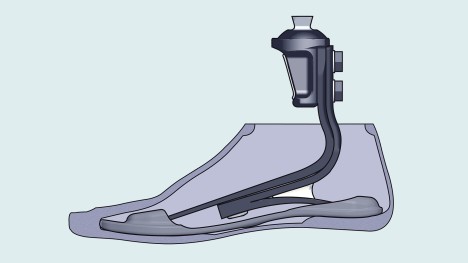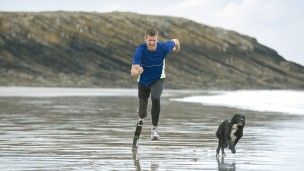Finding the best foot for you
People with lower-limb loss sometimes need a prosthetic leg system with a knee (if they are above-knee amputees) or not, if they are below-knee amputees. Most use liners, and many also use sleeves to add comfort and performance to their leg system. But everybody needs a foot!
New devices open the door to new opportunities and activities for people who need a prosthetic foot. A broad selection of feet, including many that simulate the dynamic action of an anatomical foot, can help you meet your activity goals. There are even feet specifically designed for running.
The basics | |
 Designing prosthetic foot systems is challenging. It’s very difficult to reproduce the complex workings of the human foot and ankle. Ideally the foot will be light because its weight is added to the rest of the leg prosthesis. If the foot is too heavy, the suspension system may be affected and with it the connection to the socket and your limb. A good prosthetic foot should also be strong, as it will be taking on huge force and torque as you walk and run. Feet must also be small enough to fit within a foot shell, a cosmetic covering for the prosthetic foot, and thus fit within a shoe. Being light, strong, and small, and yet functional and durable is the challenge. |  Early designs for prosthetic feet were often a solid piece of wood. A similar design, the SACH (solid-ankle-cushioned-heel) is still in use because of its sturdy function, especially useful for individuals with lower activity levels. A SACH foot typically has a rigid inner structure (wood or plastic) surrounded by a compressible foam cosmetic shell. |
 Today’s more sophisticated feet, which add more functions, are secured inside a cosmetic shell. Most people never see their prosthetic foot without this exterior shell. The cosmetic shell, which stretches around the foot prosthesis and is held in place, serves two purposes: | 
|
The foot prosthesisWhat’s inside the shell can vary dramatically. Prosthetic feet are designed to meet the needs that fit your lifestyle and activity level. Here are some factors to consider. Materials. The materials in a prosthetic foot differ by activity level. Wood, plastic and foam are usually found in feet designed for individuals who have low activity levels and require stability. Carbon fiber feet meet the functional needs for shock absorption and energy efficiency, and are lightweight as well. Comfort. A prosthetic foot has to feel good for you to meet your activity goals. Comfort allows you to be more active, and the function of your prosthetic foot directly affects comfort. Function. Prosthetic feet are designed to mimic a human foot at a specific activity level. For people who cannot walk, the function is largely cosmetic. For those who are most active, a prosthetic foot must mimic a normal foot during the act of walking. It must act as a shock absorber as you strike your heel to the ground, adapt to uneven terrain, provide a smooth rollover from heel to toe, and provide a rigid lever for propelling forward when you finish your step (“toe-off”). Multi-axial motion. Some prosthetic feet are designed to mimic the ankle, which allows the foot to move in multiple planes. Multi-axial capability in a foot allows you to raise and lower the forefoot; move the forefoot to the left and right; and roll the foot slightly to the inside and to the outside. Multi-axial motion is needed to walk comfortably and confidently on uneven ground, when your foot must adapt to whatever it encounters. Energy storage. A foot made with carbon fiber for energy storage literally gives you a spring in your step. The carbon fiber acts as a spring, compressing as you apply weight and propelling you forward as your foot rolls, returning energy to your step as the spring releases. Some prostheses have one spring in the heel and a second spring in the forefoot: just what you need for walking at various speeds, running, climbing hills or descending stairs with a secure, confident stride. With carbon fiber, the longer the spring, the more energy it can store and the more responsive the foot will be. | |


